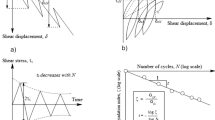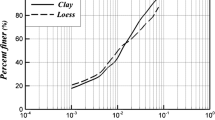Abstract
The earthquake-induced landslides frequently occur in weakly cemented soil or along the interface between two soil layers of different weathering levels. However, the investigation regarding the test procedure for determining the residual strength of weakly cemented soil is still limited. Thus, this study aims to investigate and compare the results obtained from single- and multi-stage procedures in ring shear tests, in which the multi-stage procedure was carried out by increasing and reducing normal stress as well as shear rate. In this study, the weakly cemented soil was created by mixing a small content of cement with kaolin clay. The combined specimens of two halves with different cementation were used to simulate the interface between two soil layers with different weathering levels. Accordingly, a series of single- and multi-stage procedures were performed under various test conditions on intact samples of non-cemented, weakly cemented kaolin clay, and combined samples of different cementation in ring shear apparatus. The results showed that the residual stress ratios obtained from different test methods tended to decrease as the normal stress increases, especially up to 294 kPa, except for the kaolin sample. The residual strength parameters obtained from different test methods were significantly different corresponding to sample types, with a range of difference in residual friction angle from 0.1° to 6.1°, in residual cohesion intercept from 1.5 to 39.3 kPa. In general, the residual stress ratios increased as the shear rates increased, except for the 4% cemented kaolin sample in the single-stage procedure.















Similar content being viewed by others
References
Bromhead, E.N.; Ibsen, M.L.: Bedding-controlled coastal landslides in Southeast Britain between Axmouth and the Thames Estuary. Landslides 1(2), 131–141 (2004)
Tiwari, B.; Brandon, T.L.; Marui, H.; Tuladhar, G.R.: Comparison of residual shear strengths from back analysis and ring shear tests on undisturbed and remolded specimens. J. Geotech. Geoenviron. Eng. 131(9), 1071–1079 (2005)
Chigira, M.; Yagi, H.: Geological and geomorphological characteristics of landslides triggered by the 2004 Mid Niigta prefecture earthquake in Japan. Eng. Geol. 82(4), 202–221 (2006)
Wang, H.B.; Sassa, K.; Xu, W.Y.: Analysis of a spatial distribution of landslides triggered by the 2004 Chuetsu earthquakes of Niigata Prefecture, Japan. Nat. Hazards 41(1), 43 (2007)
Has, B.; Nozaki, T.: Role of geological structure in the occurrence of earthquake-induced landslides, the case of the 2007 Mid-Niigata Offshore Earthquake Japan. Eng. Geol. 182, 25–36 (2014)
Xu, D.P.; Feng, X.T.; Cui, Y.J.: An experimental study on the shear strength behaviour of an interlayered shear weakness zone. Bull. Eng. Geol. Env. 72(3–4), 327–338 (2013)
Suzuki, M.; Hai, N.V.; Yamamoto, T.: Ring shear characteristics of discontinuous plane. Soils Found. 57(1), 1–22 (2017)
Suzuki, M.; Fujimoto, T.; Taguchi, T.: Peak and residual strength characteristics of cement-treated soil cured under different consolidation conditions. Soils Found. 54(4), 687–698 (2014)
Scaringi, G.; Hu, W.; Xu, Q.; Huang, R.: Shear-rate-dependent behavior of clayey bimaterial interfaces at landslide stress levels. Geophys. Res. Lett. 45(2), 766–777 (2018)
Duong, N.T.; Suzuki, M.: Rate effect on the residual interface strength between two different soil layers. In: Geotechnics for Sustainable Infrastructure Development. Springer, pp. 985–992 (2020)
Sagitaningrum, F. H.; Kamaruddin, S.A.; Nazir, R.; Soepandji, B.S.; Alatas, I.M.: Soil-solid interface shear strength review and its possibility on interlayer slope stability analysis. In: IOP Conference Series: Earth and Environmental Science, vol. 426, no 1 (2020).
Bishop, A.W.; Green, G.E.; Garga, V.K.; Andresen, A.; Brown, J.D.: A new ring shear apparatus and its application to the measurement of residual strength. Geotechnique 21(4), 273–328 (1971)
Bromhead, E.N.: A simple ring shear apparatus. Ground Eng. 12(5), (1979)
La Gatta, D.P.: Residual strength of clay and clay-shales by rotation shear tests. In: Harvard Soil Mechanics Series No. 86. Harvard University (1970)
Townsend, F.C.; Gilbert, P.A.: Effects of specimen type on the residual strength of clays and clay shales. In: Soil Specimen Preparation for Laboratory Testing. ASTM International (1976)
Bromhead, E.N.; Curtis, R.D.: A comparison of alternative methods of measuring the residual strength of London clay. Ground Eng. 16(4), 39–41 (1983)
Anayi, J.T.; Boyce, J.R.; Rogers, C.D.F.: Comparison of alternative methods of measuring the residual strength of a clay. Transp. Res. Rec. 1192, 16–26 (1988)
Anderson, W.F.; Hammoud, F.: Effect of testing procedure in ring shear tests. Geotech. Test. J. 11(3), 204–207 (1988)
Anayi, J.T.; Boyce, J.R.; Rogers, C.D.: Modified Bromhead ring shear apparatus. Geotech. Test. J. 12(2), 171–173 (1989)
Stark, T.D.; Eid, H.T.: Modified Bromhead ring shear apparatus. Geotech. Test. J. 16(1), 100–107 (1993)
Tiwari, B.; Marui, H.: Objective oriented multistage ring shear test for shear strength of landslide soil. J. Geotech. Geoenviron. Eng. 130(2), 217–222 (2004)
Vithana, S.B.; Nakamura, S.; Kimura, S.; Gibo, S.: Effects of overconsolidation ratios on the shear strength of remoulded slip surface soils in ring shear. Eng. Geol. 131, 29–36 (2012)
Bayin, A.; Iyisan, R.; Hatipoglu, M.; Cevikbilen, G.; Isik, A.: The effect of testing methods on residual shear strength of cohesive soils. In: 2nd International Balkans Conference on Challenges of Civil Engineering, pp. 769–776. Epoka University, Albania (2013)
Scaringi, G.; Di Maio, C.: Residual shear strength of clayey soils: the influence of displacement rate. In: Chiorean, G. C. (eds.) Proceedings of the 2nd International PhD Conference on Civil Engineering and Architecture, pp. 325–332 (2014)
Gratchev, I.B.; Sassa, K.: Shear strength of clay at different shear rates. J. Geotech. Geoenviron. Eng. 141(5), 1–3 (2015)
Scaringi, G.; Di Maio, C.: Influence of displacement rate on residual shear strength of clays. Proc. Earth Planet. Sci. 16, 137–145 (2016)
Duong, N.T.; Suzuki, M.; Hai, N.V.: Rate and acceleration effects on residual strength of kaolin and kaolin–bentonite mixtures in ring shearing. Soils Found. 58(5), 1153–1172 (2018)
Wang, L.; Han, J.; Liu, S.; Yin, X.: Variation in shearing rate effect on residual strength of slip zone soils due to test conditions. Geotech. Geol. Eng. pp. 1–13 (2020)
Tika, T.E.; Vaughan, P.R.; Lemos, L.: Fast shearing of pre-existing shear zones in soil. Geotechnique 46(2), 197–233 (1996)
Harris, A.J.; Watson, P.D.J.: Optimal procedure for the ring shear test. Ground Eng. 30(6) (1997)
Lupini, J.F., Skinner, A.E., Vaughan, P.R.: The drained residual strength of cohesive soils. In: Selected Papers on Geotechnical Engineering by PR Vaughan, pp. 88–120. Thomas Telford Publishing (2009)
Skempton, A.W.: Long-term stability of clay slopes. Geotechnique 14(2), 77–102 (1964)
Xu, C.; Wang, X.; Lu, X.; Dai, F.; Jiao, S.: Experimental study of residual strength and the index of shear strength characteristics of clay soil. Eng. Geol. 233, 183–190 (2018)
Li, D.; Yin, K.; Glade, T.; Leo, C.: Effect of over-consolidation and shear rate on the residual strength of soils of silty sand in the Three Gorges Reservoir. Sci. Rep. 7(1), 1–11 (2017)
Suzuki, M.; Umezaki, T.; Kawakami, H.: (1997) Relation between residual strength and shear displacement of clay in ring shear test. J. Jpn. Soc. Civ. Eng. 575(III40), 141–158 (1997)
Tiwari, M.; Marui, H.: Influence of clay mineralogy in residual shear strength of soil. Ann. Rep. Res. Inst. Hazards Snowy Areas Niigata Univ. 24, 7–56 (2002)
Dalla Rosa, F.; Consoli, N.C.; Baudet, B.A.: An experimental investigation of the behaviour of artificially cemented soil cured under stress. Géotechnique 58(8), 675–679 (2008)
Lee, K.H.; Lee, S.: Mechanical properties of weakly bonded cement stabilized kaolin. KSCE J. Civ. Eng. 6(4), 389–398 (2002)
Pu, S.; Zhu, Z.; Song, W.; Wan, Y.; Wang, H.; Song, S.; Zhang, J.: Mechanical and microscopic properties of cement stabilized silt. KSCE J. Civ. Eng. 24(8), 2333–2344 (2020)
Thanh Duong, N.; Van Hao, D.: Consolidation characteristics of artificially structured kaolin-bentonite mixtures with different pore fluids. Adv. Civ. Eng. 2020, 1–9 (2020)
Suzuki, M.; Taguchi, T.; Fujimoto, T.; Kawahara, Y.; Yamamoto, T.; Okabayashi, S.: Effect of loading condition during curing period on unconfined compressive strength of cement stabilized soil. J. Jpn. Soc. Civ. Eng. 792(III–71), 211–216 (2005)
Suzuki, M.; Tsuzuki, S.; Yamamoto, T.: Residual strength characteristics of naturally and artificially cemented clays in reversal direct box shear test. Soils Found. 47(6), 1029–1044 (2007)
Langroudi, A.A.; Jefferson, I.: The response of reworked aerosols to climate through estimation of inter-particle forces. Int. J. Environ. Sci. Technol. 13(4), 1159–1168 (2016)
Skempton, A.W.: Residual strength of clays in landslides, folded strata and the laboratory. Geotechnique 35(1), 3–18 (1985)
Houlsby, G.T.: How the dilatancy of soils affects their behaviour. In: Soil Mechanics Report Number 121/91. University of Oxford (1991)
Li, Y.; Chan, L.S.; Yeung, A.T.; Xiang, X.: Effects of test conditions on shear behaviour of composite soil. Proc Inst Civ Eng Geotech Eng 166(3), 310–320 (2013)
Suzuki, M.; Yamamoto, T.; Sasanishi, T.; Sugawara, M.: Residual strength characteristics of pure clay minerals prepared with different salinity. Mem. Fac. Eng. Yamaguchi Univ. 54(1), 11–15 (2000)
Suzuki, M.; Yamamoto, T.; Tanikawa, K.; Fukuda, J.; Hisanaga, H.: Variation in residual strength of clay with shearing speed. Mem. Fac. Eng. Yamaguchi Univ. 50, 45–49 (2002)
Lemos, L.J.L.: Shear behaviour of pre-existing shear zones under fast loading—insights on the landslide motion. In: Proceedings of the International Workshop on Occurrence and Mechanism of Flow-like Landslides in Natural Slopes and Earth Fills, pp. 229–236 (2003)
Bhat, D.R.; Bhandary, N.P.; Yatabe, R.: Effect of shearing rate on residual strength of kaolin clay. Electron. J. Geotech. Eng. 18, 1387–1396 (2013)
Kimura, S.; Nakamura, S.; Vithana, S.B.; Sakai, K.: Shearing rate effect on residual strength of landslide soils in the slow rate range. Landslides 11(6), 969–979 (2014)
Khosravi, M.; Meehan, C.L.; Cacciola, D.V.; Khosravi, A.: Effect of fast shearing on the residual shear strengths measured along pre-existing shear surfaces in kaolinite. In: Geo-Congress 2013: Stability and Performance of Slopes and Embankments III, pp. 245–254 (2013)
Wang, Y.; Cong, L.: Effects of water content and shearing rate on residual shear stress. Arab. J. Sci. Eng. 44(10), 8915–8929 (2019)
Carrubba, P.; Colonna, P.: Monotonic fast residual strength of clay soils. Italian Geotech. J. 40(3), 32–51 (2006)
Acknowledgements
This research is funded by Vietnam National Foundation for Science and Technology Development (NAFOSTED) under Grant No. 105.08-2019.315. The authors also would like to thank the staff at the Geotechnical Lab., Yamaguchi University, Japan, for helping us during conducting the experiments.
Author information
Authors and Affiliations
Corresponding author
Rights and permissions
About this article
Cite this article
Duong, N.T., Van Hai, N. Residual Strength of Weakly Cemented Kaolin Clay in Multi-stage Ring Shear Test. Arab J Sci Eng 47, 4437–4451 (2022). https://doi.org/10.1007/s13369-021-06132-2
Received:
Accepted:
Published:
Issue Date:
DOI: https://doi.org/10.1007/s13369-021-06132-2




